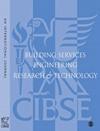Influence of gap size between aluminium radiant sheets on the efficiency of lightweight floor heating
IF 1.8
4区 工程技术
Q3 CONSTRUCTION & BUILDING TECHNOLOGY
Building Services Engineering Research & Technology
Pub Date : 2022-05-11
DOI:10.1177/01436244221099426
引用次数: 0
Abstract
For environmental and economic reasons, it is necessary to search for heating systems solutions that are efficient and provide thermal comfort at a low investment cost. In this study, the optimum gap between aluminium radiant sheets in lightweight floor heating is determined, ensuring high system efficiency and low material consumption. Numerical calculations were performed using the ANSYS. The structures analysed consist of thermal insulation covered with a 0.3 mm thick aluminium sheet, wood-like board and ceramic tiles or panels. The average surface temperature and the temperature amplitude are determined for the construction with no gap between the sheets and with gaps of 10, 20, 30 and 40 mm. Increasing the gap size results in a decrease in the surface temperature and heat flux and an increase in temperature amplitude. For a 10–20 mm gap, the decrease in temperature (<0.47 K), relative heat flux drop (<4.4%) and increase in surface temperature amplitude (<1K) can be considered negligible at a water temperature of 25–40°C, pipe spacing of 0.075–0.150 m and the thermal resistance of the layers above the pipes ≤0.118 m2K/W. A gap of 10–20 mm compared to no gap reduces aluminium consumption, which is environmentally friendly while ensuring high system efficiency.铝辐射板缝隙尺寸对轻质地板采暖效率的影响
出于环境和经济原因,有必要寻找高效且以低投资成本提供热舒适性的供暖系统解决方案。在本研究中,确定了轻质地板供暖中铝辐射板之间的最佳间隙,以确保高系统效率和低材料消耗。使用ANSYS进行了数值计算。所分析的结构包括覆盖0.3毫米厚铝板的隔热层、类似木板和瓷砖或面板。平均表面温度和温度幅度是为板材之间没有间隙且间隙为10、20、30和40 mm的结构确定的。增加间隙尺寸会导致表面温度和热通量降低,温度幅度增加。对于10–20 mm的间隙,当水温为25–40°C,管道间距为0.075–0.150 m,管道上方各层的热阻≤0.118 m2K/W时,温度下降(<0.47 K)、相对热通量下降(<4.4%)和表面温度幅度增加(<1K)可忽略不计。与无间隙相比,10–20 mm的间隙减少了铝的消耗,这在确保高系统效率的同时对环境友好。
本文章由计算机程序翻译,如有差异,请以英文原文为准。
求助全文
约1分钟内获得全文
求助全文
来源期刊

Building Services Engineering Research & Technology
工程技术-结构与建筑技术
CiteScore
4.30
自引率
5.90%
发文量
38
审稿时长
>12 weeks
期刊介绍:
Building Services Engineering Research & Technology is one of the foremost, international peer reviewed journals that publishes the highest quality original research relevant to today’s Built Environment. Published in conjunction with CIBSE, this impressive journal reports on the latest research providing you with an invaluable guide to recent developments in the field.
 求助内容:
求助内容: 应助结果提醒方式:
应助结果提醒方式:


